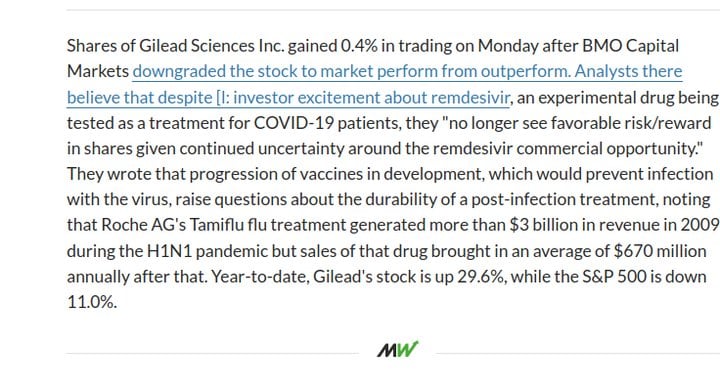Take Things More Seriously


Severe acute respiratory syndrome (SARS) is caused by a novel coronavirus termed SARS-CoV. No antiviral treatment has been established so far. Interferons are cytokines which induce the synthesis of several antivirally active proteins in the cell. In this study, we demonstrated that multiplication of SARS-CoV in cell culture can be strongly inhibited by pretreatment with interferon-beta. Interferon-alpha and interferon-gamma, by contrast, were less effective. The human MxA protein is one of the most prominent proteins induced by interferon-beta. Nevertheless, no interference with SARS-CoV replication was observed in Vero cells stably expressing MxA. Therefore, other interferon-induced proteins must be responsible for the strong inhibitory effect of interferon-beta against SARS-CoV.
Severe acute respiratory syndrome (SARS) is an infectious disease which has recently emerged in China and rapidly spread to other countries (Chan et al., 2003). To date, 8098 cases with 774 deaths are reported (WHO, 2003). Intensive research has led to the identification of a positive-stranded RNA virus, termed SARS-coronavirus (SARS-CoV), as the etiologic agent (Drosten et al., 2003, Fouchier et al., 2003, Ksiazek et al., 2003, Kuiken et al., 2003, Peiris et al., 2003).
Virus infection of mammalian cells prompts the innate immune system to establish a first line of defense. Interferons (IFNs) play a key role in these events, since they activate the innate immune system and help to shape adaptive immunity (Stark et al., 1998). Two types of IFNs are involved in establishing an antiviral state. Type I IFN (IFN-α/β) is synthesized by most cell types as a direct response to virus infection, whereas type II IFN (IFN-γ) is produced by immune cells after contact with antigen-presenting cells. Both type I and type II IFNs induce the synthesis of distinct but partially overlapping sets of mRNAs which encode proteins with antiviral, antiproliferative, and immunomodulatory properties (de Veer et al., 2001). Among the type I IFN-induced proteins, the main antiviral factors are the Mx proteins (Haller and Kochs, 2002), the 2′-5′-oligoadenylate synthetase (2′-5′-OAS)/RNaseL system (Silverman, 1994), and the protein kinase R (PKR; (Williams, 1999). Mx proteins are large GTPases that inhibit the multiplication of several RNA viruses, including representative members of the Bunyaviridae, Paramyxoviridae, Rhabdoviridae, Orthomyxoviridae, and Togaviridae (Haller and Kochs, 2002). Mx proteins inhibit virus replication at early stages of infection by affecting transcription and/or replication of the viral genome (Haller and Kochs, 2002).
In this study, we investigated the potential of different IFNs to inhibit replication of SARS-CoV in cell culture and determined whether the human MxA protein contributes to the antiviral effect of type I IFNs.
3.1. Inhibitory effects of interferons
We investigated the inhibitory effect of type I and II IFNs on SARS-CoV multiplication in cell culture. We used universal IFN-α A/D (BglII), pegylated human IFN-α, human IFN-β, and human IFN-γ. These cytokines are known to inhibit the replication of several pathogenic viruses in cell culture or in patients (Samuel, 2001). For all following experiments, Vero cells were chosen because they are unable to synthesize IFN but are fully responsive to IFN treatment (Diaz et al., 1988). Therefore, any additional effects of virus-induced IFN that would bias the results can be excluded. Cells were pretreated with the IFNs, infected with SARS-CoV, and virus in the supernatant was determined after overnight incubation. Fig. 1 shows that administration of IFN-α and IFN-γ led to a 10-fold inhibition of virus growth. IFN-β was even more potent since it resulted in a 1000-fold reduction of virus titers. We also tested tumor necrosis factor α, but found no inhibitory effect (data not shown). These data are in agreement with a recent report by Cinatl et al. (2003) and demonstrate that IFN-β is the most effective antiviral cytokine against SARS-CoV.
3.2. Virus replication in MxA-expressing cells
Mx is one of the main IFN-α/β-induced proteins which are antivirally active. Previous gene array analyses have revealed that the mRNA for the human MxA protein is induced 31-fold by IFN-β, 21-fold by IFN-α, and not at all by IFN-γ (Der et al., 1998). Due to the similarity of the antiviral effect of the different IFNs (see Fig. 1) and the pattern of MxA expression, it was suspected that MxA might be the responsible factor (Cinatl et al., 2003). Therefore, we tested growth of SARS-CoV in Vero cell lines which stably express MxA (Frese et al., 1995). These cells are widely used to demonstrate the antiviral effect of MxA against a range of RNA viruses (Haller and Kochs, 2002). The Vero cells expressing MxA (VA3, VA9, VA12) and control cells (VN36, Vero) were infected with the SARS-CoV isolate FFM-1, and viral titers in the supernatants were determined at 48 h post-infection. As depicted in Fig. 2A, no apparent differences in virus growth were detected. In all cases titers of approximately 108 infectious particles per ml were reached. Likewise, when MxA-expressing VA9 and control Vero cells were directly used in a plaque assay, no differences in the efficiency of plaque formation or size were observed (Fig. 2B). These results suggest that MxA is not the critical factor that mediates inhibition of SARS-CoV, despite its high-level induction by IFN-β. Thus, the search for antiviral effects against SARS-CoV should focus on other IFN-induced proteins such as PKR or RNase L.
The ACE2 gene encodes the angiotensin-converting enzyme-2, which has been proved to be the receptor for both the SARS-coronavirus (SARS-CoV) and the human respiratory coronavirus NL63. Recent studies and analyses indicate that ACE2 could be the host receptor for the novel coronavirus 2019-nCoV/SARS-CoV-21,2. Previous studies demonstrated the positive correlation of ACE2 expression and the infection of SARS-CoV in vitro3,4. A number of ACE2 variants could reduce the association between ACE2 and S-protein in SARS-CoV or NL635. Therefore, the expression level and expression pattern of human ACE2 in different tissues might be critical for the susceptibility, symptoms, and outcome of 2019-nCoV/SARS-CoV-2 infection. A recent single-cell RNA-sequencing (RNA-seq) analysis indicated that Asian males may have higher expression of ACE26. Currently, the clinical reports of 2019-nCoV/SARS-CoV-2 infection from non-Asian populations for comparison are very limited. A study from Munich reported four German cases, all of which showed mild clinical symptoms without severe illness7. However, the genetic basis of ACE2 expression and function in different populations is still largely unknown. Therefore, genetic analysis of expression quantitative trait loci (eQTLs)8 and potential functional coding variants in ACE2 among populations are required for further epidemiological investigations of 2019-nCoV/SARS-CoV-2 spreading in East Asian (EAS) and other populations.
To systematically investigate the candidate functional coding variants in ACE2 and the allele frequency (AF) differences between populations, we analyzed all the 1700 variants (Supplementary Table S1) in ACE2 gene region from the ChinaMAP (China Metabolic Analytics Project, under reviewing) and 1KGP (1000 Genomes Project)9 databases. The AFs of 62 variants located in the coding regions of ACE2 in ChinaMAP, 1KGP, and other large-scale genome databases were summarized (Supplementary Table S2). All of the 32 variants potentially affecting the amino acid sequence of ACE2 in databases were shown (Fig. 1a). Previous study showed that the residues near lysine 31, and tyrosine 41, 82–84, and 353–357 in human ACE2 were important for the binding of S-protein in coronavirus5. The mutations in these residues were not found in different populations in our study. Only a singleton truncating variant of ACE2 (Gln300X) was identified in the ChinaMAP (Fig. 1a). These data suggested that there was a lack of natural resistant mutations for coronavirus S-protein binding in populations. The effects of low-frequency missense variants in populations for S-protein binding could be further investigated. The distributions of seven hotspot variants (Lys26Arg, Ile468Val, Ala627Val, Asn638Ser, Ser692Pro, Asn720Asp, and Leu731Ile/Leu731Phe) in different populations were shown (Fig. 1b). Six low-frequency loci (rs200180615, rs140473595, rs199951323, rs147311723, rs149039346, and rs73635825) were found to be specific in 1KGP database, the AFs of which were also low in the gnomAD and TopMed10 database. Only two of these six variants (rs200180615 and rs140473595) could be found in CHB (Han Chinese in Beijing) population with the AF<0.01. Interestingly, the SNP rs2285666 with the highest AF in the 62 variants exhibited much higher AF in the ChinaMAP (0.556) and CHS (Han Chinese South, 0.557) populations compared to others (AMR, Ad Mixed American, 0.336; AFR, African, 0.2114; EUR, European, 0.235). In addition, the homozygous mutation rate in males (0.550) was much higher than females (0.310) in the Chinese population (Supplementary Table S2). Taken together, the differences in AFs of ACE2 coding variants among different populations suggested that the diverse genetic basis might affect ACE2 functions among populations.
To analyze the distribution of eQTLs for ACE2, we used the Genotype Tissue Expression (GTEx) database (https://www.gtexportal.org/home/datasets). We found 15 unique eQTL variants (14 SNPs and 1 INDELs) for ACE2 with q value ≤0.05 in 20 tissues from the GTEx database (rs112171234, rs12010448, rs143695310, rs1996225, rs200781818, rs2158082, rs4060, rs4646127, rs4830974, rs4830983, rs5936011, rs5936029, rs6629110, rs6632704, and rs75979613). The AFs of the 15 eQTL variants were compared among different populations. Notably, our results showed most of the 15 eQTL variants had much higher AFs in the ChinaMAP dataset and EAS populations compared to European populations (Fig. 1c and Supplementary Table S3). The AFs of the top 6 common variants (rs4646127, rs2158082, rs5936011, rs6629110, rs4830983, and rs5936029) were higher than 95% in EAS populations, whereas the AFs of these variants in European populations were much lower (52%–65%). All of the 11 common variants (AF>0.05) and 1 rare variant (rs143695310) in the 15 eQTLs are associated with high expression of ACE2 in tissues (Supplementary Table S3). For instance, the eQTL variant rs4646127 (log allelic fold change=0.314), which locates in the intron of ACE2 gene, has the highest AFs in both of the ChinaMAP (0.997) and EAS (0.994) populations. Comparatively, the AFs of rs4646127 in EUR (0.651) and AMR (0.754) populations are much lower. These findings suggested the genotypes of ACE2 gene polymorphism may be associated higher expression levels of ACE2 in EAS population.












